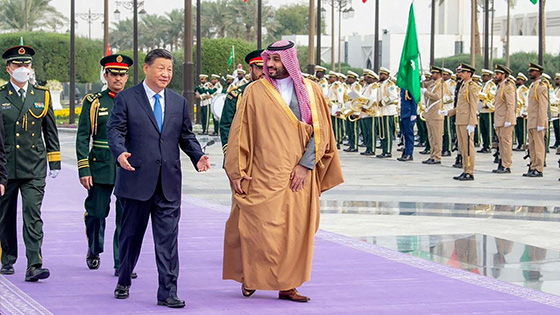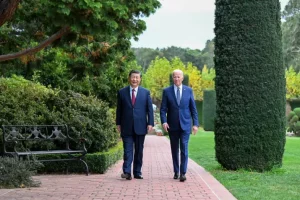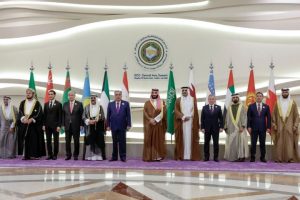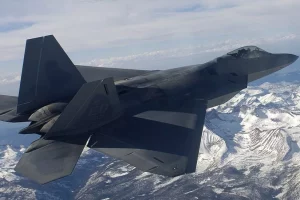Between 7-9 December, Riyadh hosted three summits: a bilateral summit, a summit involving the leaders of the six-member Gulf Cooperation Council (GCC), and a larger summit that brought together the heads of Arab countries. The guest at all three high-profile events was the Chinese President Xi Jinping, undertaking only his second foreign tour since the start of the pandemic, and his first visit to Saudi Arabia since 2016.
The pomp surrounding the visit was matched only by the rhetoric from both sides that accompanied these interactions: in a curtain-raiser, the Chinese foreign office spoke of the visit “consolidating consensus on global governance, development, security and other crucial issues”. The Saudi-China joint statement committed the two countries to a “comprehensive strategic partnership” that would reach “new and promising horizons”.
Saudi Arabia and China release a joint statement underlining the importance of global energy supplies during President Xi Jinping's trip to the kingdom pic.twitter.com/AK8URYKAhG
— TRT World Now (@TRTWorldNow) December 9, 2022
It then proceeded to identify enhancement of ties in a wide variety of areas –energy, economic, technological, security and defence, and educational and cultural, including digital education and the teaching of Arabic and Chinese languages in schools, universities and educational institutions in the two countries.
Amidst this bonhomie, the US sounded a note of caution: the State Department said that expanding Chinese presence in West Asia was “not conducive to maintaining international order”. Other commentators have been more exuberant: one wrote in Middle East Eye that the summits would perhaps shape the future of the Gulf, while another said in Asian Times that “Pax Sinica of sorts” was emerging in West Asia.
It becomes very clear for some time that Saudi Arabia is drifting (diversifying) slowly but surely away from US and joining China-Russia. pic.twitter.com/X6005UgAb4
— 🇪🇺 🇲🇨🇨🇭Dan Popescu 🇫🇷🇮🇹🇷🇴 (@PopescuCo) December 28, 2022
China in West Asia
China’s engagement with the region has been steadily expanding and diversifying over the last two decades. The GCC states provide 40 percent of China’s oil imports, with Saudi Arabia alone exporting 17 percent. This is expected to increase – Chinese oil demand is likely to go from 14 million barrels per day (mbd) in 2019 to 17 mbd in 2040.
The Gulf is also a major market for Chinese goods – over the last decade, China’s exports have grown at 11.7 percent annually, enabling China to overtake the US in 2008 and the European Union in 2020 as the region’s biggest source of imports. In 2021, China-Arab two-way trade was $330 billion, with trade with the GCC amounting to $161.4 billion. Saudi Arabia accounted for $80 billion in bilateral trade, with oil exports standing at $44 billion.
The GCC-China trade is expected to receive a fillip with the finalisation of the Free Trade Agreement that is being negotiated sporadically since 2004, with talks having been accelerated in recent months.
But China’s ties with the region have gone well-beyond energy and trade; China is today a major player in the various “Vision” strategies that each GCC country has initiated to diversify their economies from dependence on oil revenues. China’s presence is particularly important in the maritime and high-tech areas, with the development of “smart ports” across the region, and taking early steps in building an electric vehicle facility in Abu Dhabi and a flying car in Dubai
A “flying car” made by Chinese electronic vehicle maker Xpeng made its first public test flight in Dubai on October 10, 2022. pic.twitter.com/N9ei117goD
— South China Morning Post (@SCMPNews) October 12, 2022
During the visit, China and Saudi Arabia concluded several agreements, valued at $30 billion, covering different areas – energy, infrastructure, finance, technology, including telecommunications technology, that will bring Chinese participation in areas such as green energy, transport, cloud services, health and the medical sector, logistics, construction, housing and Information Technology. China’s 5G initiatives in Saudi Arabia and the UAE, promoted by Huawei, could become the base for further forays in 5G and 6G technology for broadband cellular networks.
The Belt and Road Initiative (BRI) has been a major factor in attracting China to the region: twenty Arab states are partners in this initiative and are looking at opportunities for lucrative participation in projects in both logistical and technological areas. The Saudi-China joint statement refers to the “harmonisation plan” between BRI and the Saudi “Vision-2030” that was signed during the visit.
Regional implications
Not surprisingly, both regional and western commentators see Xi Jinping’s three summits in Riyadh as a major challenge to US hegemony in West Asia. Since the late 1970s, the US has been the principal political and military presence in the region, with the Arab states providing full support to US’ strategic interests and military forays, even when, as in regard to the US attack on Iraq in 2003, they were seen as harming their own interests.
West Asia’s engagement with China is in fact only the latest manifestation of significant changes that have already been apparent in the region – changes that have signalled a “coming-of-age” on the part of the regional states, by their taking foreign policy initiatives and interactions without any US involvement or approval. The most important of these initiatives have been: the five rounds of dialogue between Saudi Arabia and Iran in 2021-22, Turkey’s outreach to Saudi Arabia, the UAE and Egypt, and the Iraq-Jordan-Egypt consortium set up in August 2021.
Saudi-Iran dialogue at ‘very good’ stage: Iranian officialhttps://t.co/rgJd7pqiwo
— The Cradle (@TheCradleMedia) August 20, 2022
More recently, in the wake of the Ukraine war, hardly any West Asian nation has accepted the US call to impose sanctions on Russia, nor have the region’s oil producers succumbed to US pressure to increase oil production, but have prioritised their own interests and the integrity of the “OPEC +” that includes Russia as a major role-player.
The principal reason for this disenchantment with the US has been the pervasive uncertainties in the region about the US’ commitment to upholding the security and political interests of its regional partners, the US’ shifting priorities, and its consistent “strategic narcissism” (in the words of former National Security Adviser HR McMaster), where the US takes for granted the support of its allies, without taking into account
H.R. McMaster: US is afflicted by "strategic narcissism," which "produces policies and strategies based on flawed assumptions, wishful thinking and short-term approaches to long-term problems." One example is the 20-year Afghan War, "fought 20 times over." https://t.co/fhPFCOyGfi
— Brahma Chellaney (@Chellaney) April 3, 2021
China poses no such burdens. Its ties with regional states are largely economic in content. They are not conditioned on extraneous considerations, such as human rights, but instead provide significant opportunities for mutually advantageous partnerships in energy, technological and logistical exchanges.
China, as an advanced country functioning within an authoritarian political framework, offers an attractive development model for West Asian states as it is non-intrusive and non-prescriptive. Above all, in its policy approaches, China pursues a long-term vision that is well-thought out and consistent, unlike the US whose policies constantly shift under domestic electoral considerations, lobbyists’ pressures, and changes in the White House.
Outlook for China and the region
The question being asked by most commentators is whether China is now poised to replace the US as the security guarantor in West Asia. This is perhaps the wrong question – China obviously has neither the will nor the capacity to challenge the US’ military presence in the region. In CENTCOM, the US has armed forces across the region, with military personnel located in several regional states. China only has a rudimentary presence – a small base at Djibouti and occasional forays of its naval vessels in parts of the Indian Ocean.
The problem here is not the formidable forces the US has in West Asia, but what strategic purposes they are meant to serve – beyond constantly threatening Iran with armed assault, there is little evidence of long-term interests or regional strategy which these forces are meant to advance. Certainly, there are no indications of the US functioning as a “guarantor” of regional security.
Nor are the Arab states signalling any alienation from the US – what is being asserted is that regional states wish to pursue their interests on their own, seek the freedom to choose their political and economic partners, and, above all, do not wish to be part of a global binary – a new Cold War – envisaged by the US. Thus, while the US will remain a major security partner of most Arab states and the principal arms supplier for the foreseeable future, it will not enjoy a monopoly in either engagement.
At the same time, West Asia will continue to see considerable Sino-US competition: in energy sales, China may be expected to encourage a shift away from the dollar to the “petroyuan” through the Shanghai Petroleum and Natural Gas Exchange and compete with the US and other western nations in providing nuclear energy for peaceful purposes.
Birth of the PetroYuan… https://t.co/inHzseys0k
— TVG (@TheVirginiaGen1) January 3, 2023
China will also attempt to expand its arms sales to the region, while setting up defence manufacturing units in selected countries: there are reports that China has set up a ballistic missile production facility in Saudi Arabia and supplied armed drones, worth about $4 billion, that the US has not been willing to provide. These are, as of now, a tiny fraction of weapons’ supplies from the US.
China is also likely to seek to expand its arc of influence by offering West Asian nations membership in “BRICS plus” and an expanded Shanghai Cooperation Organisation. China will also partner GCC and other Arab states in reaching out to Africa – the Saudi-China joint statement speaks of the two countries’ “cooperation and partnership in order to support stability and development in the African continent”.
What China and West Asia are jointly signalling is the end of US hegemony and the dawn of a new multipolar order.
(The author, a former ambassador to Saudi Arabia, Oman and the UAE, holds the Ram Sathe Chair for International Studies, Symbiosis International University, Pune.)




















